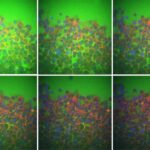
In a groundbreaking study poised to reshape cancer therapeutics, researchers led by City of Hope have unveiled unprecedented insights into the elusive protein paxillin, a key player scattered at the nexus of cell adhesion and signaling networks implicated in tumor progression. Published in the prestigious journal Science Advances, this work demystifies the complex conformational dynamics of paxillin as it interacts with a partner protein known as the focal adhesion targeting domain (FAT) of focal adhesion kinase (FAK). The findings illuminate a molecular dance that could unlock novel precision therapies targeting cancer-specific protein functions long thought too fluid and disordered to drug effectively.
For decades, the scientific community has struggled with the intrinsically disordered nature of paxillin—a protein that, unlike rigid enzymes, lacks a fixed three-dimensional structure under resting conditions. This inherent flexibility enables paxillin to act as a multifaceted scaffold, orchestrating the assembly and disassembly of focal adhesions, the cellular structures critical for mechanical sensing, migration, and survival signals. Understanding how paxillin guides these processes is paramount since cancer cells exploit its dynamic interactions to adapt, spread, and resist traditional treatments.
Dr. Ravi Salgia, the Arthur & Rosalie Kaplan Chair in Medical Oncology at City of Hope, emphasized the therapeutic potential of the study’s findings. “Disrupting paxillin’s interaction with focal adhesions is not just relevant, but potentially transformative for cancer treatment,” he stated. His team proposes that selective targeting of paxillin’s cancer-specific states could offer precision therapeutics that spare healthy cells, overcoming a major hurdle in current anti-cancer strategies.
.adsslot_lMgZK0A7IT{ width:728px !important; height:90px !important; }
@media (max-width:1199px) { .adsslot_lMgZK0A7IT{ width:468px !important; height:60px !important; } }
@media (max-width:767px) { .adsslot_lMgZK0A7IT{ width:320px !important; height:50px !important; } }
ADVERTISEMENT
The study pivots on elucidating how paxillin interacts with the FAT domain of FAK, a critical kinase that integrates signals from the extracellular matrix to regulate cell motility and survival. Previously, attempts to detail their interaction were thwarted by the proteins’ large, flexible contact interfaces and rapid conformational shifts. Through innovative use of advanced spectroscopic techniques akin to medical MRI but designed for molecular-level resolution, the researchers captured the fleeting structural snapshots of the paxillin-FAK complex.
Specifically, the team employed nuclear magnetic resonance (NMR) spectroscopy combined with dynamic computational simulations, enabling them to reconstruct a three-dimensional model of how paxillin and FAT dock. Remarkably, upon binding, both proteins undergo a conformational contraction, shrinking to fit a constrained binding groove and maintaining this compact arrangement despite their otherwise disordered tendencies. This “induced fit” mechanism contrasts sharply with the traditional lock-and-key model, highlighting a prominent theme in understanding disordered protein interactions.
Supriyo Bhattacharya, Ph.D., assistant research professor and lead computational analyst in the project, remarked on the synergy of methodologies. “By harmonizing experimental spectroscopy with in silico modeling, we achieved an atomic-level resolution of this dynamic interaction that surpasses what either method could provide alone,” he explained. This multimodal approach not only clarifies paxillin’s engagement with FAT but also sets a framework for studying other disordered proteins notoriously challenging to characterize.
Notably, the researchers suggest that the paxillin-FAK interaction exemplifies a broader class of protein-protein interactions, where disorder and flexibility are retained alongside highly specific binding events. This paradox challenges conventional drug design paradigms, which rely on stable target structures, and opens the door to innovative strategies that leverage transient conformations and dynamic allostery for therapeutic intervention.
Given paxillin’s central role in focal adhesion signaling pathways, its dysregulation is implicated in enhanced cancer cell migration, invasion, and metastatic potential. The detailed structural insights from this study provide a scaffold for designing small molecules or biologics that disrupt specific paxillin-FAK interfaces, potentially stymying cancer progression at the cellular communication level.
The research consortium was notably interdisciplinary, merging expertise from City of Hope, the University of Maryland, and the National Institute of Standards and Technology. This collaborative effort amalgamated cutting-edge biophysical techniques, computational modeling, and cancer biology to tackle the formidable challenge posed by disordered proteins in oncogenesis.
While many disordered proteins have been deemed “undruggable” due to their structural fluidity and absence of deep binding pockets, this work reframes the predicament by uncovering stable conformations that emerge transiently yet predictably during interaction. Targeting such a “moving target” requires precisely timed and structurally informed interventions, a feat made achievable by combining spectroscopy and computational simulations.
Beyond oncology, the implications of this work extend to a wide range of diseases where disordered proteins contribute to pathogenesis, including neurodegenerative disorders and immune dysfunction. The methodology and conceptual advances provided here offer a blueprint for exploring the dynamic protein interactome with unprecedented resolution.
City of Hope’s stature as a leading cancer research center underscores the significance of this breakthrough. Their integrated approach spanning fundamental science to clinical applications is primed to accelerate the development of next-generation cancer therapeutics grounded in molecular precision and minimal side effects.
In sum, this landmark study not only elevates our molecular understanding of the paxillin-FAK interplay but also pioneers novel avenues for drug discovery targeting disordered protein interactions. As researchers adapt these insights into clinical pipelines, a new frontier in battling cancer’s resilience and adaptability is rapidly approaching.
Subject of Research: Cells
Article Title: Conformational dynamics and multimodal interaction of Paxillin with the focal adhesion targeting domain
News Publication Date: 18-Jun-2025
Web References:
Science Advances Article
City of Hope
References: 10.1126/sciadv.adt9936
Keywords: Cells, Paxillin, Focal Adhesion Kinase, Protein Dynamics, Cancer Therapy, Disordered Proteins, Structural Biology, Spectroscopy, Computational Modeling
Tags: cancer cell signaling pathwayscancer therapeutics advancementscellular microstructures in cancerCity of Hope research breakthroughsdisordered proteins in oncologyfocal adhesion kinase interactionsmechanotransduction in cancernovel cancer treatment strategiespaxillin protein dynamicsprecision therapies for cancerprotein-targeted cancer therapiestumor progression mechanisms


